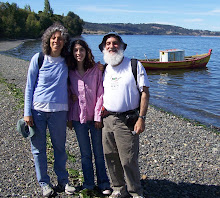Around our living room for the first night of Passover were 7 Chileno friends (one an 18-month-old), 5 American students or post-grads living in Chile, and the 4 of us (Linda, Jonathan, Shira, with Ruhi in the midst of a 2-week visit). We conducted the Seder in Spanish and we heard new tunes to a lot of the traditional songs. In the South American autumn we were celebrating the coming of spring.
During the week before Passover we rented a car for a 4-day trip to the north. Our destination was el Valle de Elqui,
 a movingly beautiful area that contrasts fertile, lushly green, narrow valley floors with steep, barren mountains. It is known for producing grapes for wine and for Pisco, a grape brandy that is sort of the Chilean national drink and from which a number of popular flavored cocktails are made.
a movingly beautiful area that contrasts fertile, lushly green, narrow valley floors with steep, barren mountains. It is known for producing grapes for wine and for Pisco, a grape brandy that is sort of the Chilean national drink and from which a number of popular flavored cocktails are made.We made our way there first heading up the coast, stopping at the picturesque, upscale resort of Zapallar.
After Jonathan made a friend at a roadside rest stop,

we went inland to the market town of Ovalle where we spent the first night. We took a long, dusty, sinuoso (very winding), sometimes treacherous, but spectacularly beautiful unpaved road
along the Rio Hurtado up to Vicuña in the heart of the
Our initial plan was to spend one night at lodgings that had been recommended to us – Tesoro del Elqui – in Pisco Elqui, but as soon as we arrived at around 6 p.m., with the sun setting behind orange peaks, we decided we would stay for two nights. The lodge and the town were beautiful, romantic and charming.
We took a hike up a remote arroyo (dry river bed) with steep cliffs on either side and views of
the Andes.We visited a village of artisans (pretty deserted in the off-season) and had a night-time telescope-viewing astronomy lesson – this is touted as one of the clearest places on earth to view the night sky.  We made a friend – a massage practitioner whose property (where we saw our first ever persimmon tree) is adjacent to the place we were staying, whose name is Anahata (the heart chakra) and whose mother’s family name was Finkelstein.
We made a friend – a massage practitioner whose property (where we saw our first ever persimmon tree) is adjacent to the place we were staying, whose name is Anahata (the heart chakra) and whose mother’s family name was Finkelstein.  We had a couple of excellent meals and bought some locally produced wine for our Seder.
We had a couple of excellent meals and bought some locally produced wine for our Seder.
 We made a friend – a massage practitioner whose property (where we saw our first ever persimmon tree) is adjacent to the place we were staying, whose name is Anahata (the heart chakra) and whose mother’s family name was Finkelstein.
We made a friend – a massage practitioner whose property (where we saw our first ever persimmon tree) is adjacent to the place we were staying, whose name is Anahata (the heart chakra) and whose mother’s family name was Finkelstein.  We had a couple of excellent meals and bought some locally produced wine for our Seder.
We had a couple of excellent meals and bought some locally produced wine for our Seder.On the way home we took another spectacular unpaved road to Parque Nacional Fray Jorge, an anomalous sliver of temperate rain forest (due to the abundant sea mists) amid the desert hills, where we saw a couple of rare guanacos (related to llamas).
where we saw a couple of rare guanacos (related to llamas).
 where we saw a couple of rare guanacos (related to llamas).
where we saw a couple of rare guanacos (related to llamas).
Many of the places we went to on this trip were isolated, remote, and deserted – just the way we like it! Thus, in the days just before Passover, we had our own journey to the wilderness, with all of the beauty and awe and none of the oppression and hardship. We returned in time to prepare for an unforgettable Chilean Seder with our family (4 out of 5 any way) and good new friends.




